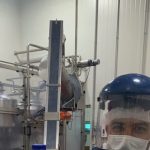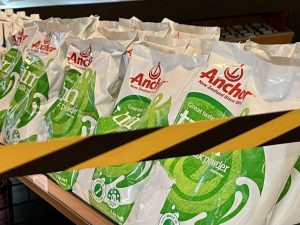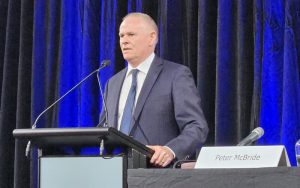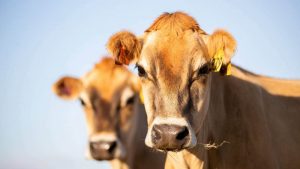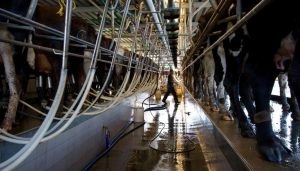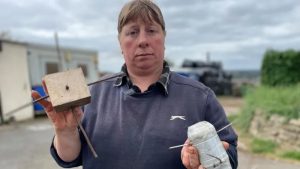
The question for Canterbury is dairy cows or stygofauna? Does it want agricultural riches or pristine water trickling through the aquifers of its plains?
Well actually, Environment Minister David Parker has already decided the answer.
In September, in an election-friendly move, Parker dropped the boom on New Zealand’s water quality standards with a tough new National Policy Statement (NPS) for Freshwater Management.
The time for trading-off the economy against the environment is over, Parker said.
And heads are still reeling this has become a legislative fact.
Environment Canterbury (ECan) councillor Lan Pham – a Christchurch freshwater ecologist and longtime campaigner for clean water – admits to being a little gobsmacked.
Beaming from ear to ear, she struggles to express the enormity of the reversal. “This is like … it’s literally … I mean, councils are scrambling to figure out what this really means,” Pham stutters.
In Canterbury especially, it matters.
Memories are still fresh from the last time central government swooped in to change the rules of the game.
That was 2010. Using the excuse ECan, the regional council, had become split down the middle between its greenie and pro-farming factions, a National Party government sacked the council table and installed its own team of commissioners to push through irrigation projects.
It was a green light for dairy conversions and Canterbury quickly gained 60 per cent more cows in a few short years. Central pivots and milk powder processing factories popped up everywhere on the plains.
But now Parker – with far less public fanfare – has come in over the top of that.
Pham says it ought not feel like such a complete surprise because the key principle driving the revised Freshwater NPS – Te Mana o te Wai – has been in the documentation since 2014.
Te Mana o te Wai is the bicultural presumption that New Zealand’s lakes and waterways have their own mauri, or life force, which needs protection.
In any hierarchy of values, the rights of the water itself are primary. And so the rather Pākehā notion of negotiating public interest balances – this much economic development for that much environmental degradation – can no longer fly.
Pham says Te Mana o te Wai was first incorporated into the 2014 version of the Freshwater NPS, following Māori Party and Iwi Leader Group representations. Yet this was only as a general aspiration.
“The idea of upholding the mana of the water came through there. But it had no statutory weight at the time.”
Pham says in a further 2017 rewrite, the wording was upgraded to councils needing to give the principle “due consideration”.
With the latest move, however, it is suddenly the law – a regulatory bottom line.
“Te Mana o te Wai is now a clearly defined hierarchy where the health and wellbeing of the water comes first. And that shift is monumental,” she exclaims.
Pham says heads are reeling because it cuts across everything Canterbury has been doing since 2010 under the commissioner-led Canterbury Water Management Strategy (CWMS). What happens to that framework now?
And how in particular is it going to affect the current Plan Change 7 (PC7) hearings – a water zone decision pitting the rights of Waimakariri farmers against the future security of Christchurch’s aquifer water supply?
An issue that had been feeling reasonably well settled in Canterbury is about to be reopened in a big way, Pham says.
And as the stringency of the new NPS standards become apparent, the question for nitrate-intensive farming activities like dairy on the Canterbury plains is whether they can indeed survive?
Rewriting regional plans
Politics is politics, of course. It is conceivable that Parker’s NPS won’t stick. Pham says the truth is Parker has only initiated a “direction of travel”.
The Freshwater NPS became operative on September 3. But regional councils have until 2025 to rewrite their existing water regulations. Some of the critical benchmarks are still being haggled over. And there will be the inevitable pushback from the farming lobby.
Federated Farmers North Canterbury president Cam Henderson has been quick to declare the rules unnecessary because Canterbury has put so much effort into developing its own restrictions on nitrate leaching and other water issues through the CWMS.
“Our current regional plan already deals with improving water quality in a much more targeted and effective way. We are talking years of council work to reassess farms. And in the meantime, action on improving freshwater quality stands still,” says Henderson.
However Pham replies it is significant the NPS announcements have not created that much of an uproar frankly. There weren’t muck spreaders spraying the steps of Parliament.
Pham says even farmers know the New Zealand public is onboard with the need to get real about the country’s declining water quality.
So what Parker has done is reset the rules of engagement.
On the one hand, Te Mana o te Wai now makes it a science-driven debate, she says. The starting question is what are the nutrient levels that define ecologically healthy water? That is what will set the bottom line.
But the other side of this question is how fast in practice can New Zealand move towards the NPS goals.
If there is to be political fudging, it will be about the timelines involved.
Hidden in the groundwater
The problem for farmers – and indeed cities, as the NPS will apply to urban waterways like Christchurch’s Avon River too – is the nutrient restrictions on freshwater are going to have to be incredibly strict to achieve the standard implied by Te Mana o te Wai.
Dr Jenny Webster-Brown, director of the Lincoln-based research initiative, Our Land and Water National Science Challenge, has been part of the standard setting process as a member of the Freshwater Science and Technical Advisory Group.
She says the water of the South Island especially – its alpine lakes and braided rivers – is naturally pristine.
Even trace amounts of nitrate and phosphate from farm run-off can act like fertiliser and upset the delicate balance of the aquatic ecosystems.
And in Canterbury, with its thin, shingly, soil, there is a whole hidden ecology to consider – a stygofauna that lives in the plain’s groundwater.
Webster-Brown says the rivers, with their fish and invertebrates, are just the visible surface features of a vast flowing sheet of water – the plain’s aquifers – which can take hundreds of years to complete their journey from the mountains to the ocean.
This makes a buried world under nearly every Canterbury paddock colonised by its own specially adapted life forms – shrimp-like isopods, water mites, snails, worms, and other tiny native species.
So there is more to be protected than people realise. If the promise to follow the science is kept, you can see how it will end up setting a very high bar, Webster-Brown says.
Nitrate is the key number in Canterbury. The first Freshwater NPS in 2008 created a human drinking water limit of 11.3 milligrams per litre, the level at which nitrates can cause health conditions like Blue Baby Syndrome.
However Webster-Brown says 11.3mg/l is far above what most New Zealand aquatic species are adapted to. So the next move was to introduce nitrate limits that were safe for water life.
In 2014, a bottom line of 6.9mg/l was agreed. Still way too high the ecologists said.
When Parker became Environment Minister, he told the scientists he wanted serious measures. “He had a lot of us in the room putting our hands up and asking are you sure?”
The limit became 3.8mg/l as a level giving a 90 per cent confidence freshwater species would survive.
And by the time the NPS was finalised in September, that had been argued down to 2.4mg/l, representing a tighter 95 per cent level of confidence.
But Webster-Brown says it probably won’t stop there as 2.4mg/l is a toxicity measure – the amount of nitrate that would eventually poison a delicate species if you dumped it in a bare fish tank.
In the real world, especially under the hot Canterbury sun, the nitrate problem is not so much toxicity as eutrophication. The nitrate causes algal blooms which starve the water of oxygen. That is what fish or invertebrates die of first.
So if eutrophication is the true issue, then the science says an acceptable level of nitrate has to be pushed below 1mg/l.
Webster-Brown says the advisory group became split over the toxicity versus eutrophication argument and so 2.4mg/l was written into the NPS.
However the debate has only been parked. “We agreed to revisit it over the next 12 months,” she says.
The way things are going – with Te Mana o te Wai now driving government policy – 1mg/l could well be where it lands up in another year.
Political collision
Parker’s approach does represent a radical philosophical change.
The view is that regions like Canterbury were encouraged to put economic growth ahead of long-term sustainability. Now central Government is going look after the environment first.
The way it is going to work can be seen with some of the tough new regulations – the National Environmental Standards (NES) – around stock fencing and winter grazing that were included in the recent NPS announcement.
And not only have regional councils been given four years to rewrite their existing environment plans, but a new national Freshwater Hearings Panel has been formed to ensure they all toe a similar line.
Yet where things get fuzzier is timescales. Is it about hitting the stringent water quality targets in 10 years or 100 years?
Parker has talked about restoring New Zealand’s waterways “within a generation”, suggesting about 30 years. But even his environmental supporters feel that could be ambitious.
And what happens as his NPS framework starts to cut across existing processes like the CWMS in Canterbury?
Federated Farmers environment spokesperson Chris Allen, a mid-Canterbury sheep and beef farmer, says the danger is that – as North Canterbury’s Henderson argues – a heavy-handed Wellington approach could derail the good progress the region has already been making.
Allen says the CWMS was set up as an example of local democracy. Canterbury was divided into 10 catchment-level zone committees to make community decisions on how to meet ECan’s water targets.
It was reasoned this ultra-local approach would produce the best real world decisions.
“We’ve been through a collaborative limits-setting process where you had all the competing interests in the room – the green NGOs, the farming interests, the irrigation companies, the environmentalists,” says Allen.
That has been going on for 10 years with hundreds of meetings. A huge investment of time. And it has educated all sides.
Allen says environmentalists have learnt the economic realities of how fast farming can move. Farmers in turn have accepted responsibility for making the moves. “Now you risk sidelining the community that has done the hard yards.”
For example, on his own farm, Allen has been steadily making changes to deal with soil pugging, the muddy damage cows can do to fields during winter grazing.
To stop sediment washing into creeks, he has dug swales and planted grassy margins – a simple practical solution.
But now there is a new NES with some bureaucratic rule about banning hoof prints deeper than 50mm. Imagine policing that, Allen says.
This is what he means. The CWMS was about educating farmers to think environmentally and so work to prevent problems in the first place. Now Parker wants to impose fiddly regulations that will wrap farming in red-tape.
Claire McKay, an ECan councillor and Waimakariri dairy farmer, agrees. She says the CWMS has built up tremendous social capital.
It has brought all sides together to forge catchment agreements about the best balance between economic growth and environmental values.
Canterbury is well ahead of the rest of New Zealand because of it. The only hope is that commonsense will rule and the new NPS targets will be phased in at an affordable pace.
“There’s a lot of fear and uncertainty about what the future looks like,” McKay says.
“This is big changes being expected. If they were small changes spread over a longer timeframe, then people would deal with them far easier.”
Must do better
The farmer argument is Canterbury is doing so much to improve water quality that it could be left to continue its existing plans.
But environmentalists counter saying the CWMS has to be judged on where it actually landed up on its target setting.
ECan’s Pham says, for example, the zone plans for the dairying districts of Hinds and Selwyn were heralded as a win. They promised to get local river nitrates down below 6.9mg/l – the 2014 NPS target – through a 30 per cent reduction in nitrate run off over 15 years.
“You think, wow, 30 per cent. That’s a hefty change, right?”
But 6.9mg/l is way above the eutrophication threshold. It will still leave streams and rivers vulnerable to algal blooms and summer oxygen starvation.
“If it’s only going to get you there, what’s the point? Why would we even put this economic burden on people to not then achieve a functional environment?” That is why much more aggressive action is needed, says Pham.
And with the new NPS in force, that is likely to have almost immediate impact, she says. Canterbury could provide a first test case with its PC7 hearing going through its final evidence and due for a decision mid-2021.
The major issue is the threat to Christchurch’s aquifer from the dairy farms which have sprung up all along the north bank of the Waimakariri River over the past decade.
Dr Doug Rankin, giving evidence as a PC7 objector and spokesperson for the river recreation group, Whitewater NZ, says hydrological modelling has shown that ancient gravel beds form porous channels which connect the stony ground beyond the river to the aquifer beneath Christchurch.
So cow urine dumped out there is eventually – given 200 to 1200 years – going to wind up polluting even the deepest levels of the city’s famously pure drinking water.
This highlights a problem with local democracy, Rankin says. One zone potentially gets to decide another zone’s future, even if the threat feels conveniently far off in the future.
The Waimakariri Water Zone Committee has proposed a target of limiting the ultimate increase in Christchurch’s nitrates to 3.8mg/l – the NPS value being talked about a year or so back. And getting to that number through a series of 15 per cent farm plan cuts spread over the next 60 years.
Christchurch City Council is arguing the goal must be to limit any nitrates in the aquifer to below 1mg/l. And the dairy farmers ought to be told to achieve an immediate 40 per cent reduction within 10 years.
Rankin says before the current NPS rewrite, it looked like Christchurch might not get much of a say. PC7 is still being heard under the special ECan Act powers which govern the CWMS process. Whatever the independent hearings panel decided could only be appealed on points of law.
But now the hearing panel should have to take into consideration the way the ground rules have been changed.
Pham agrees. That is one of the questions ECan’s own officers have been scrambling to answer, she says.
“And the legal advice right now is they will have to give ‘substantial weight’ to that Te Mana o te Wai hierarchy.”
So it might not be too long before Canterbury has a clearer answer about the impact of the new NPS limits, says Pham.
A choice to make
It is early days. A lot could change depending on how hard farmers contest the changes. And in the wake of Covid-19, the economic argument might start to weigh rather more heavily.
If New Zealand tourism has been trashed for a good few years, and the national debt has blown out, how much pressure will a returned Labour government want to place on the country’s agricultural sector?
Freshwater bottom lines might be created, but the timelines stretched.
However if environmental policy is now following the science, that should be alarming for Canterbury agriculture where dairy cows on its bony plains were always an obvious ecological risk.
Federated Farmers’ Allen says Hinds and Selwyn farms were looking at spending a lot of time and money just to achieve the 6.9mg/l goal agreed under the CWMS.
“That was already a pretty stretched target. And now the government has set this new national bottom line of 2.4mg/l.”
McKay says the viability of dairy farming would be threatened if the government starts unpicking every catchment plan that has been agreed. But she warns that many other kinds of agriculture – like potato and crop growing – would find it a struggle to meet a 2.4mg/l or 1mg/l limit too.
So agricultural riches or pristine water? Canterbury might have thought it had its workable compromise sorted out by the CWMS. But the whole question has just been reopened again.


